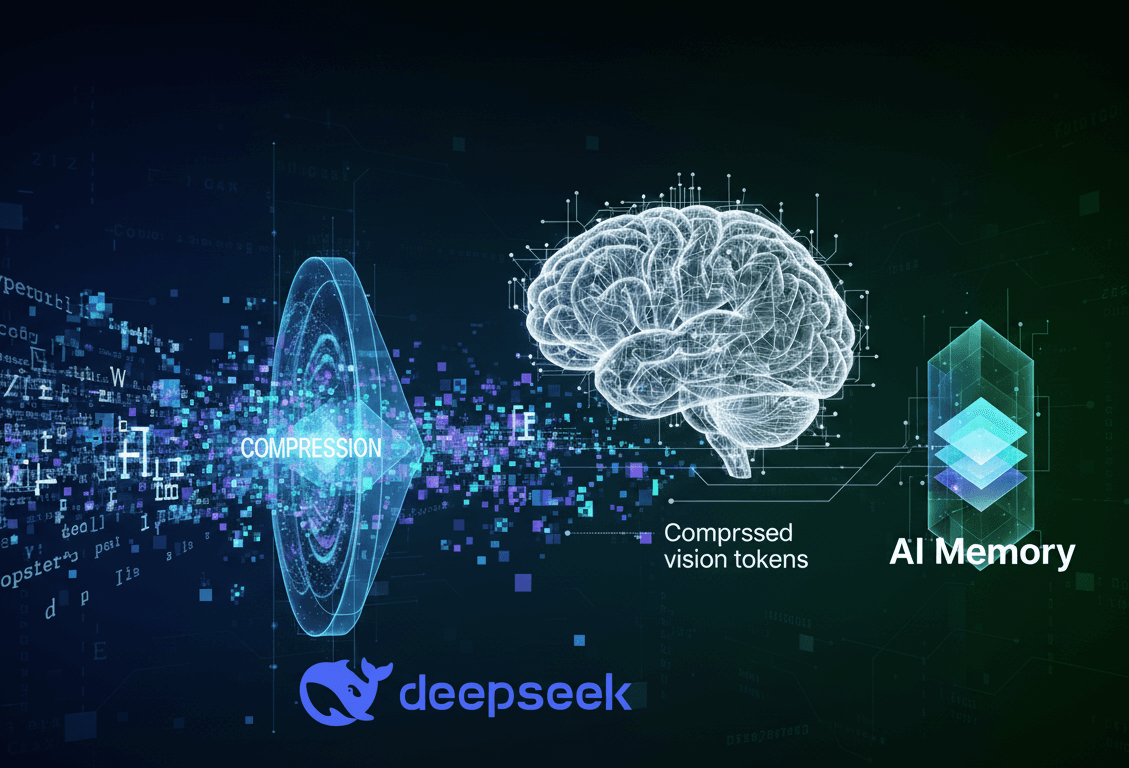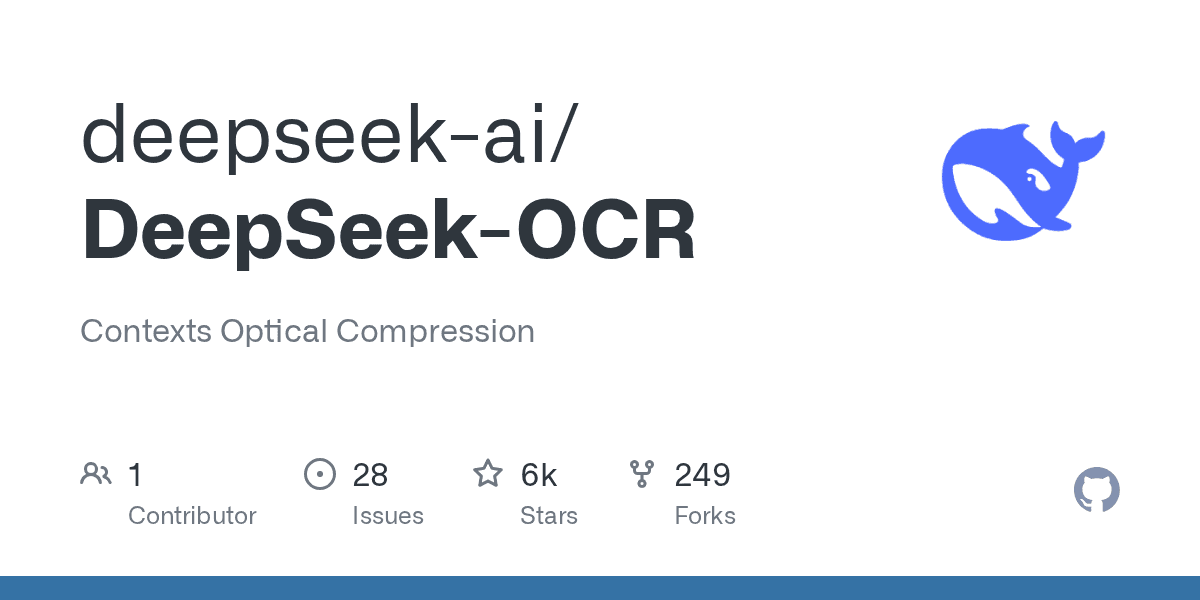
DeepSeek OCR Contexts Optical Compression: A New Era for AI Memory
Introduction
Have you ever wondered how AI models process vast amounts of text without getting overwhelmed? I know I have. Large language models (LLMs) often struggle with remembering details from really long documents or conversations. That's where DeepSeek OCR steps in with something truly smart: "Contexts Optical Compression."
This isn't just about reading text; it's about giving AI a better memory. I want to show you how this approach converts huge chunks of text into small visual cues, letting AI handle much more information than before. It's a significant step forward for how our AI friends learn and understand the world, making them much more capable.

Understanding Contexts Optical Compression
Let's talk about the core idea behind DeepSeek OCR's approach. Instead of feeding an LLM raw text, which can be inefficient for long documents, DeepSeek OCR uses vision as a powerful compression tool. It converts textual data into a visual format, much like turning a detailed report into a concise infographic. This allows the model to represent a huge amount of information with a significantly smaller number of vision tokens.
How does vision help compress text data?
Vision helps compress text by capturing the spatial relationships and overall layout of text, not just the individual characters. It's like seeing the entire page at once rather than reading word by word. This visual representation is far more compact and efficient for AI to process.
What are vision tokens and how do they work to represent text?
Vision tokens are small, encoded visual representations of textual data. They work by distilling key information and patterns from the text's optical 2D mapping into a format that AI can quickly understand. This process allows LLMs to overcome traditional limitations of context window size. I find this especially interesting because it means AI can now process and recall information from extremely long documents or conversations without losing context. If you're curious about the technical details, I recommend watching this explanation of the DeepSeek OCR paper. 💡
The Deep Encoder - How DeepSeek OCR Achieves Compression
So, how does DeepSeek OCR actually pull off this clever compression? It all comes down to its "deep encoder," which is a sophisticated two-stage system. I think of it as a specialized pipeline designed to be incredibly efficient.
What are the key components of DeepSeek's deep encoder?
The key components are a SAM (Segment Anything Model) in the first stage and a Convolutional Neural Network (CNN). The second stage then uses a CLIP (Contrastive Language-Image Pre-training) model. This combination ensures thorough and intelligent compression.
How do SAM and CLIP models contribute to this compression process?
In the first stage, the SAM model focuses on capturing high-resolution details from the converted visual data. Then, a CNN compresses these visual representations, making them much smaller. The second stage uses a CLIP model to apply global attention, which helps the system understand the relationships between these compressed pieces of information. This multi-stage process is vital because it ensures that all essential textual context is retained, even after significant compression. I find this multi-faceted approach really smart for maintaining data integrity. You can really dig into the code and architecture by exploring the DeepSeek OCR GitHub repository.
Beyond OCR - Implications for AI Memory
While "DeepSeek OCR" might make you think only of optical character recognition, I want to emphasize that its impact goes much further. This technology is fundamentally redefining AI memory and how large language models handle long contexts.
How does DeepSeek OCR extend beyond just reading documents?
DeepSeek OCR extends beyond reading documents by transforming how AI processes and stores information from any long text. It's not just about extracting characters; it's about compressing the meaning and context of vast text into a manageable format for AI to "remember."
What does this mean for the future of AI's ability to remember and process long interactions?
By compressing text into vision tokens, LLMs could potentially handle the equivalent of 10-20 million text tokens. This means AI could remember entire conversation histories, analyze huge datasets, and understand complex relationships across extremely long-form content. For me, this opens up possibilities for AI systems that are far more capable and knowledgeable in nuanced interactions. If you're intrigued by the broader implications for AI memory, I suggest checking out the discussions on Hacker News about AI memory advancements. 🌐
Compression Ratios and Accuracy
Let's look at the numbers because they tell an impressive story about DeepSeek OCR's efficiency. I always appreciate clear data when evaluating new tech. This research clearly shows how effective it is at compressing textual information.
How efficient is DeepSeek OCR's compression?
DeepSeek OCR is remarkably efficient, achieving a 10x compression ratio where 100 vision tokens can represent 1000 text tokens. This means a significant reduction in data size without sacrificing much quality.
What accuracy can we expect at different compression levels?
At a 10x compression ratio, the system achieves an impressive 97% accuracy. Even when pushing it further to a 20x compression ratio (where 50 vision tokens represent 1000 text tokens), it still maintains around 60% accuracy. This balance between high compression and strong data fidelity truly highlights the potential of contexts optical compression for managing large volumes of text data in AI systems. I think this flexibility in compression levels is a key advantage depending on the application's needs. 📈
Practical Applications and Future Potential
The practical applications of DeepSeek OCR's contexts optical compression are truly vast, and I'm excited about what this means for AI. Imagine what we can build with AI systems that have such an extended "memory."
Where can we see DeepSeek OCR making a practical impact?
We could see DeepSeek OCR making a practical impact in areas like:
- Legal analysis: LLMs could summarize entire legal libraries effortlessly.
- Customer service: Analyzing years of customer service interactions to find patterns.
- Research: Generating comprehensive reports from massive research papers.
- Healthcare: Processing extensive patient records for better diagnostics.
What are the exciting future possibilities for AI with this technology?
This technology paves the way for AI systems with dramatically expanded context windows. This allows them to grasp nuances and correlations across incredibly long inputs. I envision a future where AI can engage in more coherent, informed, and sustained conversations and analyses without losing track of crucial details. It's about building AI that truly understands the bigger picture. To stay updated on their work, you can read more on DeepSeek's open-source initiatives. 🤖
Did you find this article helpful?